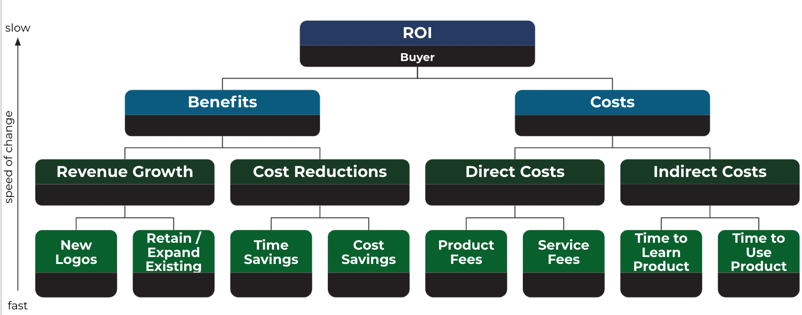At Prodify, we often use the Key Outcome Pyramid with our clients to help them identify the relationship between metrics, decide which metrics to track, and contextualize metrics that require attention.
For the customer of a typical B2B SaaS product, the key outcome pyramid might look something like this:

In this example, the overall goal—what customers are looking for—is good ROI, and the pyramid shows how the benefits of the product outweigh the costs. That key customer outcome is the top of the pyramid, and the next level then breaks this outcome into benefits and costs, which are then further broken down into categories and then specific dimensions.
The left side of this ROI pyramid focuses on the benefits your product drives for the customer. Will you help them grow top-line revenue more efficiently? An example of a product that does this is HubSpot’s Marketing Automation, which sends automated emails to help convert leads to customers. Will you help customers cut costs by saving time? An example of a product that does this is Mixmax’s one-click meetings, which saves time by replacing back-and-forth emails to schedule meetings with people outside of your company with a web app that lets those people see your availability and pick a date and time that works for them. Note that there might be other benefits you can deliver to customers that aren’t shown in this example pyramid, such as regulatory compliance or reduced data security risks.
The right side, then, breaks down the costs. First, there are direct costs, such as paying for the product. Then there are indirect costs, such as the time and money it takes to integrate data systems and provide customer support for the white-labeled solution. By breaking down both benefits and costs into specific dimensions, you get a clear picture of how well you’re meeting the customer’s key outcome.
When we worked at Opower, a company operating in the sustainability space, our key customer outcome was the cost per kWh saved in residential energy usage. Our utility buyers used this metric to compare Opower’s behavioral energy efficiency program to other programs, such as LED light bulb installation. Our utility clients’ ROI came down to:
- The benefit of cost savings (if millions of households used less energy, the utility didn’t have to pay to generate that electricity)
- The costs of the Opower behavioral energy efficiency program (in addition to an ongoing subscription, there was also an up-front integration fee to send us energy usage data)
Note the product implications of this: if we wanted to increase our product price, it had to deliver more energy savings, otherwise the ROI could drop so much that we looked less attractive than other energy efficiency programs.
Closing Thoughts
We use the idea of key outcomes and this specific example to build the customer-centric muscle in organizations. The concept reminds teams what "value" means to customers (revenue growth, cost savings, time savings, regulatory compliance, etc), and how to ensure your product is delivering the outcome they seek. If you'd like to try to create a key outcome pyramid for your product, you can download our worksheet here.
-1.png)
